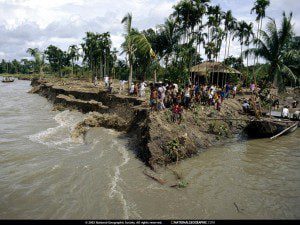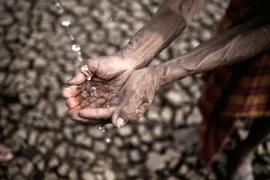
Introduction
It has long been recognized that environmental factors have an impact on migration; but until recently the issue received comparatively little attention within mainstream debates about the movements of people, both within and between States. Disasters hit Bangladesh almost every year and cause much destruction to the lives and livelihood of the people and render huge damage to the economy. The effects are compounded again by climate change which is spreading over time and space. Increased hazards like floods and excessive rainfall-induced higher river flow leads to increased river bank erosion. Tidal surge and turbulence in the context of sea level rise (SLR) lead to increased coastal erosion and salinity intrusion. Increased rainfall triggered water flow during the monsoon in the back drop of SLR and congested/silted water ways lead to water logging. In addition, recent occurrences of major cyclones like SIDR 2007 and AILA 2009 may be an indication of more frequent and severe climatic catastrophes. As a result people are losing their lands, assets, livelihood opportunities and forced to leave their own land and become internally displaced. In Bangladesh people are forced to migrate from one place to another due to natural hazards and disasters. Combined with poverty, lack of resources, population growth and institutional inaptitude people are more susceptible to natural disasters, resulting in more and regular displacement and international labour migration in the long run. Migration adds an explicit layer of complexity to the scenario.
Climate Change: Bangladesh perspective
Bangladesh, a low-lying deltaic country of South Asia, is currently facing many climate change related challenges: sea-level rise, floods, drought, cyclone, saline inoculation, river bank and coastal erosion and water-logging. Bangladesh is the most vulnerable nation due to global climate change in the world according to German Watch’s Global Climate Risk Index (CRI) of 2011. This is based on the analysis of impacts of major climate events that occurred around the world in the twenty year period since 1990. The reasons are complex and extremely intertwined. In terms of the impact of climate change few places in the world will experience the range of effects and the severity of changes that will occur in Bangladesh, which will include: average weather temperatures rising; more extreme hot and cold spells; rainfall being less when it is most needed for agriculture, yet more in the monsoon when it already causes floods; melting of glaciers in the source areas of Bangladesh’s rivers altering the hydrological cycle; more powerful tornados and cyclones; and sea level rise displacing communities, turning freshwater saline and facilitating more powerful storm surges. Among the nineteen coastal districts in Bangladesh twelve are directly exposed to cyclones and tidal surges. Since 1970, 26 major cyclones hit Bangladesh, with 18 of them occurring in the last 20 years. About 19 million people were affected by them. In the last five years, two high intensity cyclones hit Bangladesh: one was the super cyclone SIDR of 2007 and the other was cyclone AILA of 2009.
Defining Internally Displaced People (IDP)
Many terms and concepts such as environmental or climate change migrants, environmentally induced or forced migration, ecological or environmental refugee or climate change refugee, environmental displacement are used in the literature of migration. K. David defines environmental displacement as persons who are initially forced to migrate due to environmental effects.
The IOM Migration Research Series publication 31 identifies that the meteorological impact of climate change can be divided into two distinct drivers of migration: climate processes such as sea-level rise, salinization of agricultural land, desertification and growing water scarcity; and climate events such as flooding, storms and glacial lake outburst floods. But non-climate drivers, such as government policy, population growth and community-level resilience to natural disaster, are also important. All contribute to the degree of vulnerability people experience.
According to Internal Displacement Monitoring Centre (IDMC), the internally displaced people (IDPs) are defined as: “Persons or groups of persons who have been forced or obliged to flee or to leave their homes or places of habitual residence, in particular as a result of or in order to avoid the effects of armed conflict situations of generalized violence, violations of human rights or natural or human-made disasters, and who have not crossed an internationally recognized State border.”
At the 1996 International Symposium on “Environmentally-induced Population Displacements and Environmental Impacts Resulting from Mass Migration” the phrase “Environmentally Displaced Persons” were identified as “Persons who are displaced within their country of habitual residence or who have crossed an international border or for whom environmental degradation, deterioration or destruction is a major cause of their displacement, although not necessarily the sole one.”
In case of Bangladesh, there are mixed features of the displacement ranging from those being displaced temporarily during the onset of disasters; those who are displaced and unable to return to their place of habitation that has been ravaged by disasters; and those who migrated in distant locations with little or no intention to return.
Climate change-induced migration in Bangladesh
In the 21st century the world could see substantial numbers of climate migrants—people displaced by either the slow or sudden onset of the effects of climate change. Overall migration across national borders is already at approximately 214 million people worldwide, with estimates of up to 20 million displaced in 2008 alone because of a rising sea level, desertification, and flooding. Migration can result from different environmental factors, among them gradual environmental degradation and natural disasters.
In the case of Bangladesh, both internal and international labour migration plays an important role in the development process. Each year 400,000-500,000 Bangladeshis officially migrate abroad as contract workers. The number of internal migrants is assumed to be more than double of international migrants. Besides, it has a diaspora population of 1.5 million. In 2010, they sent $11.6 billion as remittances. The figure was equivalent to 56.15% of the total export earnings of the country. Migrant remittances are 12 times more than the Foreign Direct Investment (FDI) flow and 6 times more than Overseas Development Assistance (ODA). After the most recent cyclone AILA, seasonal migration from affected areas increased manifold. At least 100,000 people are still living on embankments. A large number of local people are considering permanent out-migration.
At present, there is no comprehensive documentation in Bangladesh on the trend, number and impact of the internal displacement due to disasters and climate change. 4th assessment report 2007 of Intergovernmental Panel for Climate Change (IPCC) depicts a scenario where a 1m sea level rise will displace 14.8 million people by inundating a 29,846 sq. km. area. Increased river bank erosion and saline water intrusion in the coastal areas are likely to displace hundreds of thousands of people. These people will then be forced to migrate often to slums in Dhaka and other big cities. If sea level rise is higher than currently expected and coastal polders are not strengthened and/or new ones built, six to eight million people could be displaced by 2050 and would have to be resettled.
Research findings reveal that on an average 2% (3 million) in cyclone, 25% (39 million) in flood, 0.1% (50,000) in river bank erosion and 3% (5 million) in drought were displaced over the years. There are some other environmental and natural reasons that cause temporary and permanent displacements within the country which have social, economic, environmental and gender implications. According to the World Development Report 2010, about 18% of Bangladesh’s land might submerge if the sea level rises by one meter. Should this occur, it will result in the displacement of almost 30 million people.
The pattern of migration from climate hot-spots
The pattern of migration will include both internal and international. The poor people having poor income will be forced to migrate to the adjacent districts/ Upozilas or in Dhaka. On the other hand, the lower, lower middle and middle class will migrate to neighboring countries, gulf and even to Europe and North America depending on their social network and ability to bear migration cost.
Migration to bordering countries: Some border districts of Bangladesh (Khulna, Satkhira, Bagerhat) are also the coastal areas and susceptible to inundation due to sea level rise. The people from these districts have already a very strong social network in India. A large number of people from these districts are working in many provinces. Moreover, people of bordering districts of both countries share more or less a common culture that facilitates a regular communication between them both through formal and informal channels. So it can be predicted that the inundation of land would increase the flow of migration both in regular and irregular channels to India from Khulna, Satkhira, and Bagerhat.
Migration to Middle East: Studies related to labor migration show that currently 7 million Bangladeshis are working abroad and nearly 3 million of them are in the Gulf countries. Among these 3 million a greater portion of people is from Barisal and Patuakhali. It is assumed that depending on their existing social network, people from the greater Barisal region will be likely to migrate to Middle Eastern countries.
Irregular migration to the developed countries of the West: Recently a large number of people are migrating from Shariatpur and Madaripur districts (which are also affected by river bank erosion and soil salinity) to Italy and Spain. The concentration is so high that some of the areas have been renamed. For instance: Italy Nagar in Shariatpur, Italir more in Madaripur etc. People even tend to sell their existing assets in order to go to these developed countries, often taking risk through irregular channels.
Internal migration-low land to high land: It is evident that people from islands like Sandip, Vhola, Hatia, Kutubdia etc. are gradually migrating to the high lands of Chittagong like Sitakunda, Miresarai etc. As these lands are most vulnerable to cyclone, storms and sea level rise, so people often maintain a second home in relatively high land areas. Moreover, it is observed that a large number of people from Vhola district is currently staying in USA and other developed countries of the west.
Internal Migration- rural to urban: It is assumed that the poor people hit hard by sea level rise will be forced to migrate to the adjacent districts which are relatively high land and other urban centers where they may find their livelihood as rikshawpuller, street worker etc.
Monga and Internal Migration: Seasonal economic depression (monga) visits the northern regions of Bangladesh, like Rangpur, Gaibandha, Kurigram, Nilphamari every year. Topography and climate make the Northern Region of Bangladesh ecologically vulnerable to destabilizing variations including floods, river erosion, drought spells, and cold waves, all of which occur more frequently and intensely than in other regions. Amidst these compelling conditions, the local economy shows little diversification and is heavily dependent on agriculture – which yields only one or sometimes two annual harvests, in contrast with three crops per year in more fertile and benign parts of the country. In this setting, local employment is limited from September through December. As the landless and poorest survive on agricultural wage labor, their opportunities and ensuing incomes drop in this period and thus they become trapped in what is called Monga- a cyclical phenomenon of poverty and hunger. During this period every year, substantial numbers of boys and men migrate to cities and more benign rural regions, in search of work.
Migration as an adaptation strategy: The real challenge for Bangladesh
It is interesting to note that none of Bangladeshi policies or action plans deals with the issue of migration as an adaptation strategy. The National Adaptation Programme of Action (NAPA) and the Bangladesh Climate Change Strategy and Action Plan (BCCSAP) are mostly concerned with building capacity and resilience against climate change effects through localization of problems although it is found that migration of family members in the time of distress provides much-needed economic support to survival of the households. Moreover, it is now clear that some of the most vulnerable communities, such as those living in low-lying coastal areas or drought-prone areas, they will not be able to continue their livelihoods over the next few decades in those locations. Hence the concept of migration as an adaptation strategy is beginning to emerge.
Where there are many negative effects on households, communities and countries of origin arising from migration, due largely to the loss of labour, in most cases, and in aggregate, migration seems to contribute positively to the capacity of those left behind to adapt to climate change. It also most often leads to net gains in wealth in receiving areas. These findings are heavily context dependent, but broadly they suggest that migration can enhance capacity to adapt to climate change. Many of the benefits of migration for the adaptive capacity of communities of origin arise through remittances. Remittances have many positive effects, including that they: smooth consumption of basic needs such as food across seasons; sustain access to basic needs in times of livelihood shocks such as drought; finance the acquisition of human, social, physical and natural capital; and increase demand and so stimulate local production. Families with labour migrants who remit incomes live better during livelihood crises than those that do not.
Most importantly, the resources that flow from migrants to areas of origin are not merely transfers of money between individuals and households. Networks of migrants have been known to pool resources and invest in public good facilities such as schools and health clinics.
In case of Bangladesh, both internal and international labour migration plays an important role in the development process. Organized internal and international migration can play a significant role in facing the challenges of climate change. Therefore, there is no scope of viewing migration as threat. The government of Bangladesh should incorporate it as an important adaptation strategy. The Overseas Employment Policy should incorporate the provisions for facilitating international migration from potential climate change affected areas. Thus the population movement threat can be transformed into an opportunity in the adaptation process of climate change induced displacement in Bangladesh.
Conclusion
Climate change is predicted to aggravate many existing migratory pressures in Bangladesh. The projections for future displacement driven by climate change are daunting. In the absence of a systematic process to distinguish economic migrants from those of climate-induced, the apparent nexus between climate change and migration is still often treated as coincidental. In Bangladesh, migration is commonly perceived as a failure of adaptation. But managing migration as an adaptation strategy can hugely reduce overall vulnerability particularly in climate hot-spot areas. In this context, migration must be voluntary rather than forced. Once again, the government has a key role to play alongside donors, NGOs and civil society groups.
Md. Selim Reza works as Research and Communications Officer at the Refugee and Migratory Movements Research Unit (RMMRU), University of Dhaka.
The article was originally published in FAIR Magazine in February 2015.







